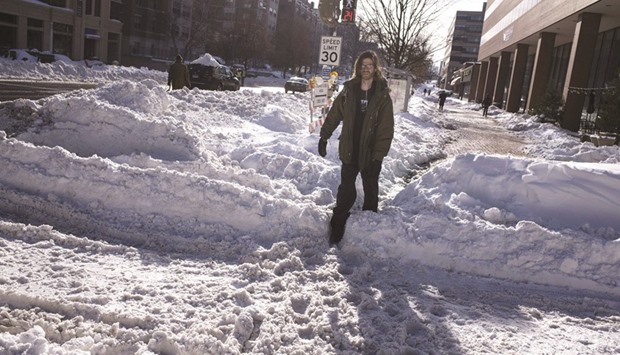Officials in Washington, DC, warned residents yesterday that it would take several more days for the city to return to normal after a massive weekend blizzard dropped more than 2’ (60cm) of snow along the East Coast and killed more than 30.
The nation’s capital was at a standstill, with federal government offices ordered shut yesterday, schools in the district and surrounding suburbs shuttered and the US House of Representatives cancelling all votes until next week.
Washington’s mayor, Muriel Bowser, urged residents to stay off the streets while crews cleared snow from secondary roadways, parking lanes and highway shoulders.
“It’s important to know that the roads are still dangerous,” she told reporters. “We knew that we would have ... several days of clean-up ahead of us. Know that we’re going to be dealing with snow all of this week.”
Officials reported at least 34 storm-related deaths, including traffic accidents and heart attacks while shovelling in Washington, DC, Delaware, Kentucky, Maryland, New Jersey, New York, North Carolina, Ohio, South Carolina, Tennessee and Virginia.
Washington’s subway resumed limited service yesterday, offering free travel in an effort to encourage the use of mass transit over driving.
“It’s beautiful to watch but impossible to get through,” said John Salmons, a 24-year-old designer who works at an architecture firm, as he waited for a train in suburban Arlington, Virginia.
Even with federal government offices officially closed, the Supreme Court was open for business, scheduled to issue rulings and act on pending appeals from the snowbound courthouse across from the US Capitol building.
Ten public schools around the city opened to provide breakfast and lunch to low-income children who typically receive free meals at school, officials said.
High snowbanks at street corners made travel within Washington difficult for pedestrians.
“The hardest part was getting the stroller through the unclean sidewalks,” said Isam Qahwash, a 41-year-old scientist from Princeton, New Jersey, as he carried his 14-month-old son in a stroller across a downtown street. “It seems like they move really slow cleaning the snow here.”
New York was quicker to return to business, with the New York Stock Exchange and the city’s public schools opened as usual.
The state’s governor, Andrew Cuomo, said weekend road closures throughout New York City and its eastern suburbs had saved lives by keeping people off the streets, reduced traffic accidents and allowed work crews to plow more efficiently.
Air travel remained seriously affected as some 1,516 US flights were cancelled yesterday, with Newark Liberty International Airport, New York’s LaGuardia Airport and Washington Dulles International Airport the hardest hit, according to FlightAware.com.
“This has been a nightmare,” said Mary Lavigne, 34, as she waited at LaGuardia with her 18-month-old daughter for a flight to Montreal. “We’ve come to the airport twice, only to have to go back home. Calling the airline was useless unless you like being on hold ... the trip is proving as brutal as the storm.”
The blizzard was the second biggest snowstorm in New York City history, with 26.8” (68cm) measured in Central Park by midnight on Saturday, shy of the record 26.9” (68.3cm) set in 2006, the National Weather Service (NWS) said.
The NWS said that 22.4” (57cm) fell in Washington at the National Zoo, and Baltimore-Washington International Airport notched a record 29.2” (74.2cm).
The deepest regional total was 42” (106.7cm) at Glengarry, West Virginia.
In Times Square, a taxicab-yellow John Deere tractor and crews wearing red jumpsuits cleared snow from pedestrian plazas, in hopes that tourists would return as the temperatures rise above freezing.
“It’s beautiful and terrible,” said Maria Murillo, visiting New York from Fort Lauderdale, Florida, with her husband Jorge, and seeing snow for the first time.
“This is the terrible part,” said Jorge, his canvas sneakers soaked as the couple struggled to cross street corners where melting snow formed puddles more like small ponds.

A man walks over a pile of snow to cross a street yesterday in Washington, DC
